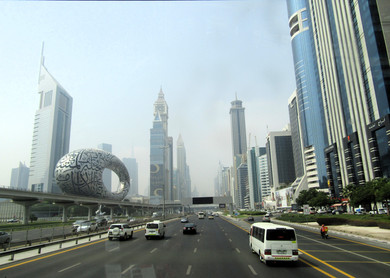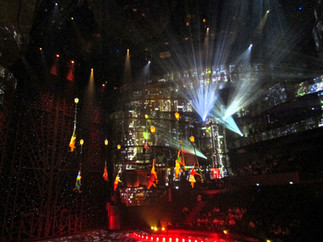The temperature is 34 degrees C at 5 o'clock in the morning and it's super-humid. As we step off the plane, my glasses fog up for the first of many times in the day. The temperature is expected to reach 39 today and hover around 44 for the next few days while we're here, with 50 to 60 per cent humidity.
It's very misty in the morning, and the haze doesn't dissipate during the day. We discover that the haze is fine particles of sand, blowing in from the desert that surrounds the city. Dubai is an emirate of about 4 million people, a city perched on the Persian Gulf and swaddled by the Arabian Desert. The second most populous emirate in the United Arab Emirates is Abu Dhabi, with about 2 million inhabitants; the UAE in total has a population of about 10 million.
So here we have a spanking new, sparkling city in the middle of the desert. In some ways it feels like a toy town that has been assembled on a sitting-room carpet. Most cities grow around a key port, or river, or defended by a range of mountains, but there's no geographical reason for Dubai to be here. It's a hereditary billionaire's --- vision? whim? genius? folly?
Dubai is a 99.9% built environment and oddly, it has a strange charm. The architecture is playful, pretty and ambitious. It sparkles, literally, in the harsh conditions. And buildings just keep on rising. Cranes sprinkle the city, although we did see the occasional abandoned construction site with diggers and bulldozers sitting sadly on the sand.
Amongst the shiny, vertical, streamlined skyscrapers, one building stands out: the Museum of the Future. It's extraordinary. The words in Arabic calligraphy are actually windows; the words were written by the Dubai ruler and relate to Dubai's future. The shape is a torus, like a doughnut. But this ain't no doughnut.
Where's the museum, you ask? Part of it is located in the green hill below the building, there are seven floors in the building itself and the void (or hole in the doughnut) is also an element. According to the museum info: The circular building represents humanity; the green mound represents the earth; the void represents the unknown future.
What? The future is a void? Sounds a bit prophet of doom-ish.
There's also a strong focus on children and children's activities. So, did we go inside? No. We're a bit over digital museums. Plus the (noisy, excited) children thing. But it is a spectacular building to look at.
And there's a hand in front of the museum. It's 12 metres tall. (Hand sculptures seem to be cropping up in our recent travels. https://www.julie-anne.online/post/punta-del-este ) This hand sign ('the 3-finger salute') was 'invented' by the UAE ruler in 2013, and shows the W for Win, the V for Victory and the L for Love. The official line is that 'the sign has become a trademark gesture for many UAE citizens and residents and symbolise work ethic, success and love of the nation'.

Dubai is spread out along the coastline, a narrow strip of development that includes significant land reclamation from the sea. It's all sun, sand and sea. The city is so hot that metro stations have been built close together, so that commuters don't have to walk too far to get the train. The stations are above ground and offer airconditioned relief to all passersby.
In its early incarnation, in the late 19th century, Dubai was a pearling and fishing town, and some old buildings remain in the area closest to the old port. To my great annoyance, Dubai Museum, housed in the Old Fort, is currently closed to visitors. I was looking forward to browsing through historical artefacts ... such as they'd be in such a modern city.
The Frame is one of Dubai's newer tourist attractions; there's a lift inside to the top. From the viewing area at the top of the Frame, you look one way towards 'the new' part of the city and the other way towards 'the old'. I guess if you look downwards towards 'the void', you're looking to the future? (Joke.) Given that we have booked for cocktails in the highest lounge in the world later in our stay, we resist the opportunity to whoosh up the Frame. Plus, we're not sure what we'd see through the haze.
Okay, there is a geographical feature that runs through Dubai: the Dubai Creek. Water taxis called abras ferry people across the creek for 1 dirham, about 50 Australian cents.
In a slightly more expensive outing, we did a dinner cruise down (up?) the Dubai Canal. An artificial water canal about 3 km long, it connects Dubai Creek to the sea. The construction of the canal created new public spaces, a new shopping centre, hotels and restaurants, housing, walkways and cycle paths. And obviously, (more expensive) waterfront accommodation.
The cruise was followed by a Cirque du Soleil-type spectacular show in a spectacular theatre. There were aerialists and swimmers and dancers and water that came and went all over the stage. It seemed like a very lavish, very Dubai sort of theatre experience. Thoroughly enjoyable, apart from the beers that were A$28 each. Photos were permitted, in case you're wondering.
More to come.


































































It looks great. Have a wonderful time!
people With personal experience of life in Dubai, who may have lived there or worked there or merely visited the Emirates will have some knowledge and understanding of Dubai but few I suspect would be able to bring together key elements of the place in such a welll balance and concise article. It will be interesting to find out if exposure to Dubai’s opulent and exotic shopping experience will colour the judgment Along the line of the Madonna song, “well I am living in the material world and I am a material girl”. Dubai is changing all the time. “Plus ca change. Plus La meme chose”. A very thought provoking article.